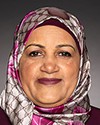Yes, 120,000 is the current figure by OCHA, the UN humanitarian aid coordinating agency, of IDPs in camps. These are the ones who are listed by the government and are receiving assistance, because, as I said to your colleague earlier, some of them do not and live in shacks and huts. They are not provided with regular assistance, just with donations, which are not directly official.
The problem in Rakhine State is not just the camps; it's also the population in other Muslim Rohingya villages around the camps. The difference between them is only the fact that they didn't have their houses burned down during the violence, whereas the 120,000 did lose everything. But in terms of access to health care, freedom of movement, access to livelihood, they face the same restrictions.
The authorities mentioned these restrictions as being for security reasons. I would say that's probably partly true, but I also think that something should be done to try to help defuse the situation. It's not going to be easy, as I said, but when I asked many people during my last visit what causes these restrictions of movements, I was told that it was a mixture of orders by the authorities, people being stopped at checkpoints, Rakhine Buddhists threatening the Rohingya that if they go out of their villages they will be attacked, and also fear among the Rohingya community. So addressing that of course is a key problem; and access to health care, and also education and livelihood, are all related to this issue of freedom of movement and access to services.





